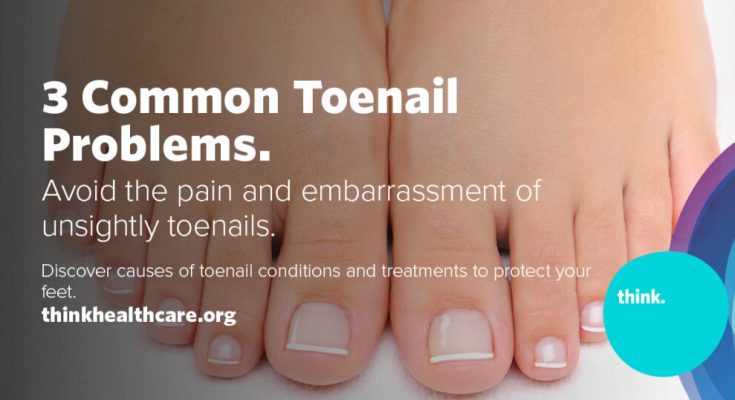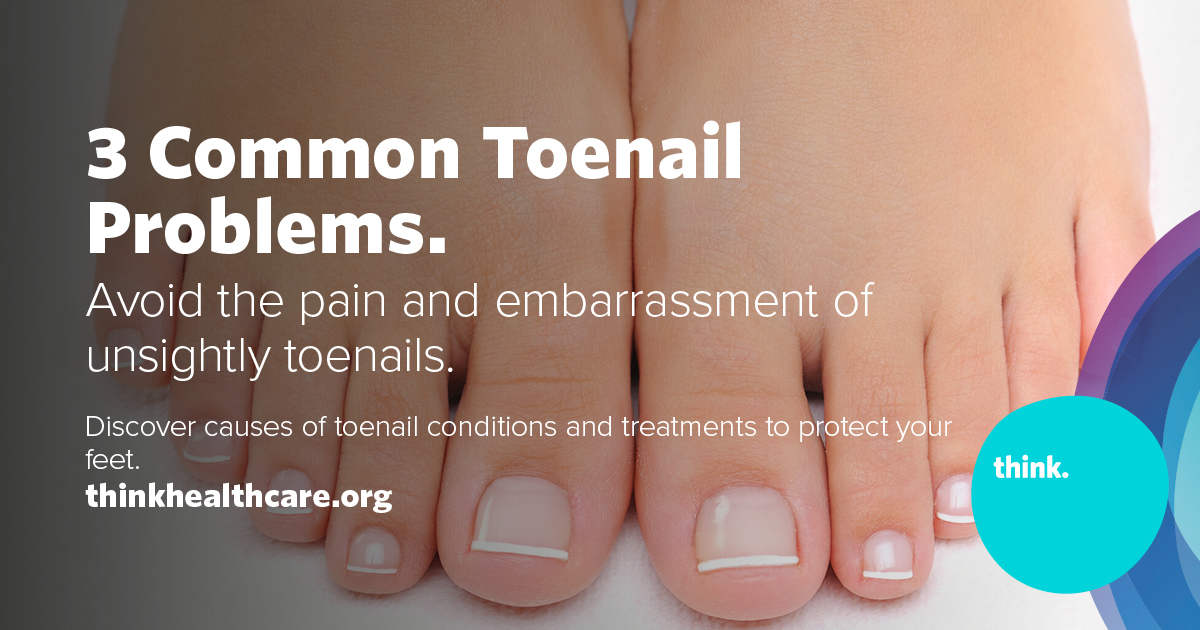Foot Health: 3 Common Toenail Problems
Trading winter socks for open-toed shoes when your toenails need medical care can be frustrating and embarrassing. With April being National Foot Health Awareness Month, let’s look at 3 common toenail problems and see how I can help. As a podiatrist, more commonly known as a foot doctor, I see and treat a gamut of toe conditions that often embarrass and frustrate my patients. Since April is National Foot Health Awareness Month, let’s look at three common toenail problems.
Common Toenail Problem 1: Toenail Fungus
Onychomycosis, toenail fungus, is an infection under the toenail surface caused by microscopic fungi. The toenail often becomes darker or white marks appear across the nail. As the fungal infection goes deeper, the toenail may thicken and crumble on the edges. The thicker, infected toenail is more difficult to trim and may make walking painful. The fungal infection can spread to other toenails, the skin or even fingernails. A secondary bacterial or yeast infection may accompany onychomycosis around the nail plate. Nail fungus can lead to permanent damage to your nails and complete nail removal.
Causes
Anyone can get a fungal nail infection. Toenails are vulnerable to fungi especially in damp public areas where you walk barefoot such as swimming pools, showers and locker rooms. Fungal germs can enter your toenails through small cracks in your nail or surrounding skin. A nail injury or pressure from ill-fitting shoes can also leave your toenails susceptible to several types of infections. If you have a chronic disease including diabetes, circulation problems or a weakened immune system, your toenails are more prone to fungal infection. A history of smoking, athlete’s feet or excessive perspiration can also lead to fungal nails. Undergoing chemotherapy can also cause fungal nail infections.
Diagnosis and Treatment
At think Podiatry, we thoroughly examine your toes and feet and typically confirm a fungal infection diagnosis with microscope or lab testing before we prescribe antifungal treatment. Stubborn toenail fungus infections do not usually go away on their own. One of the best treatments is an oral antifungal pill. It may take months to a year to rid your toe(s) of the infection. Sometimes after treatment, a fungal nail infection can reoccur. This is more common in people with underlying health conditions that put them at higher risk for fungal infections.
Common Toenail Problem 2: Ingrown Toenail
If your toenail edge presses into the skin around your toenail and continues to grow, this can cause inflammation, redness and pain and lead to infection. This medical condition is onychocryptosis or simply ingrown toenail. Ingrown toenails are most common on the big toes. If new skin tissue starts growing over the toenail, the tissue can look like small granules. If the toenail area gets infected, the inflamed area may bleed or weep pus and smell unpleasant.
Causes
A toenail can become ingrown if:
- The toenail is cut too short or with rounded edges.
- Shoes are worn too tightly.
- Feet become excessively sweaty.
- A genetic condition causes atypical toenail growth shape.
- A person is overweight.
- A person is diabetic which can affect the feet and toenails.
- Water is retained by conditions such as heart or kidney failure.
- A person takes certain medications for cancer treatment.
Diagnosis and Treatment
If your ingrown toenail is not healing on its own or you suspect the toenail or toe is now infected, do make an appointment to see me or Dr. Copple, our other podiatrist. You may need a blood test, for example, to rule out complications including cellulitis. How we treat an ingrown toenail depends on the severity of the condition. Some ingrown toenails require minor office surgery. If the inflammation is mild, soaking the toe in soapy, warm water and then applying an antiseptic or anti-inflammatory gel, tincture or cream should help.
Common Toenail Problem 3: Thick, Hardened Toenails
Toenails can become thick and hardened with age or from a fungal infection, injury or health conditions such as psoriasis or diabetes. As toenails become thicker they can become brittle and easy to break and lift from the nail bed itself. Hardened toenails are more difficult to trim and they can crack and split more easily. Depending on the cause of the hardened toenails, they can also form a foul odor and cause discomfort and pain.
Causes
Fungal and yeast infections (see above) are the most common cause of thick, hardened toenails. Other causes include:
- Sudden or repeated trauma or injury to the toenail (i.e., soccer players, runners).
- Shoes worn too tightly.
- Yellow nail syndrome, a rare disorder can lead to yellowed, thickened toenails and fingernails.
- Psoriasis, an autoimmune disorder that typically presents with red, scaly patches on the skin can also produce thick, discolored and pitted toenails.
- Paronychia causes inflammation, redness and swelling around a toenails skin and over time the nail thickens and hardens. Exposure to cleaning solutions and other irritants can cause this condition.
- Aging can thicken and harden nails, which health professionals often attribute to slower blood circulation and long-term ultraviolet light exposure.
Diagnosis and Treatment
Some cases of thick toenails, from aging for example, do not need treatment and the person can simply buff the rough surfaces to smooth them. We regularly see think patients with thick, hardened toenails, and our goal is to improve the nail’s condition and prevent further problems.
If a fungal infection is the suspected root cause of the thick toenails, I may swab under the nail or take a nail clipping to test for fungal presence. The sooner we can diagnose a fungal infection, the more likely we can cure the condition. Treatment for thick, hardened toenails may include prescription ointments and creams, oral or injection medications, laser or light therapy or surgical removal of the toenail to allow it to regrow.
Conclusion
National Foot Health Awareness Month is a great time to pay extra attention to your feet and ankles. Your podiatry team at think is here all year-round to assist with toenail conditions, arthritis and joint pain, injuries, plantar fasciitis and more. We specialize in managing and treating symptoms and pain with your ankle and/or foot.
Our goal is to provide compassionate whole person healthcare that improves your everyday life. Because think features doctors, specialists, advanced practice providers and skilled medical teams all in one accessible building, you will receive the best healthcare option in the Omaha metro area. So take a step in the right direction and make an appointment to see us. Your sandals, flip-flops and bare feet are eagerly waiting for you.
NEED MEDICAL CARE? CONSIDER THINK YOUR GO-TO FOR BETTER HEALTH
Think Whole Person Healthcare is dedicated to keeping you healthy through preventative care and treatment for a wide range of medical conditions. From the bothersome stomach upset to the persistent back pain, our physicians, advanced practice providers and specialists are committed to you and your family’s lifelong health and well-being.




